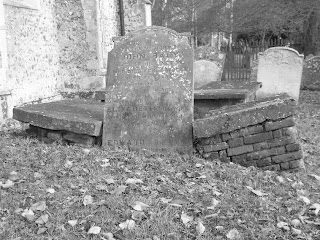 |
Flintwork on the porch
© Godric Godricson
|
The Cemetery at Saint Michael's, Great Cressingham, is a little sad in nature and the brief trial video at the bottom of this posting (taken in August 2011) captures something of that forlorn appearance. The cemetery is walled on 2 sides with monuments propped along the walls. The enclosing wall cuts the cemetery and the Church off from the majority of the sparsely populated community which serves as a commuter village for Norfolk. The cemetery has poor and largely uncut grass and this weak growth gives the impression of neglect and a lack of attention to detail. Whatever the reality of the actual groundsmanship undertaken at Great Cressingham, the casual visitor is left with the perception of a parish that doesn't really care about how it looks and has no respect for either the quick or the dead. The interior of the Church is covered by a
magnificent website which I encourage you to look at although after reading the piece one can understand how the cemetery itself is somewhat neglected.
 |
A frequent message
© Godric Godricson
|
There are no large monuments in the cemetery and the monuments that do exist are often late Victorian and early 20th Century with little artistic merit although they do speak about the faith of the departed and especially of the family left behind. The large and hilly cemetery is still used and the cemetery is a place where we witness a unity across many generations and across almost endless years. This is a place where the people of Great Cressingham all go, in good time, and are laid to rest in a place hallowed by use and tradition. However, we can only speculate as to how the place would look more attractive with a little care and attention from the parish and/or the Episcopalian Authorities.
The village of Great Cressingham has, like a lot of villages, forgotten about the departed and the Anglican Authorities have allowed such neglect to happen.









